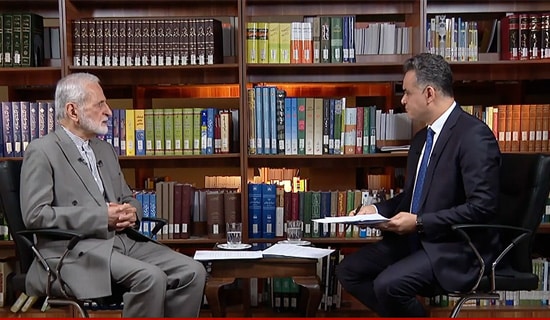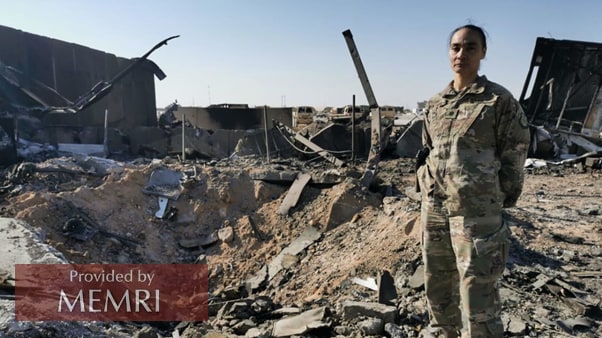
Lt. Col. Staci Coleman, Commander of 443rd AES, Ayn Al-Asad Airbase (Source: PressTV (Iran) Twitter, January 13, 2020)
This is the third part of a series on the Iran-U.S. crisis.[1]
Introduction
The Islamic Republic of Iran takes great pride in its January 8, 2020 ballistic missile attack, dubbed "Operation Martyr Soleimani," against the U.S.'s Ayn Al-Asad airbase in Iraq. The attack, in which 11 missiles struck the base, was carried out in retaliation for the January 3, 2020 drone strike that killed Qassem Soleimani, commander of Iran's Islamic Revolutionary Guard Corps (IRGC) Qods Force and Iran's most influential military leader.
Key members of the Iranian regime have glorified this attack as a pivotal event in the conflict between Iran and the U.S. Iranian military officials, religious leaders, and statesmen have presented it as evidence of Iran's strength, and as proof that Iran is determined, fearless, and capable of successfully confronting the United States.
Yet the question arises: How could it be that a barrage of 11 ballistic missiles against the largest U.S. military base in Iraq, which is home to approximately 2,000 U.S. servicemembers, did not kill or physically injure so much as one American soldier?[2]
The Ayn Al-Asad attack may have been, for both parties, a way out of the crisis between the U.S. and Iran – and this may have also been deliberate. A casualty-free attack against U.S. forces could both enable Iran to save face by "retaliating" for Soleimani's killing, and at the same time allow the U.S. to quickly end the confrontation following the killing of Soleimani without further escalation or drawn-out consequences.
Iran Inflates U.S. Casualty Numbers
Following the attack, the Iranian regime and its representatives trumpeted varying accounts of the strike, the extent of the U.S. military's casualties, and the significance of the strike vis-à-vis Iran's military capabilities. On January 8, 2020, Iranian state news agencies claimed that 80 Americans had been killed and 200 wounded in the attack.[3] That same day, Iranian Supreme Leader Ali Khamenei called the attack a "slap" to the Americans.[4] Nine days later, on January 17, Khamenei said that Ayn Al-Asad airbase had been "crushed" by Iran's strike.[5] Assembly of Experts and Guardian Council chairman Ahmad Jannati claimed that the airbase had been completely destroyed.[6]
On January 9, 2020, IRGC Aerospace Force commander Gen. Amir Ali Hajizadeh stated in a press conference following the attack that "many" American soldiers were killed by Iran's missiles. He elaborated that there were so many casualties that nine C-130 transport planes and "a large number" of Chinook helicopters were needed to evacuate the wounded to Jordan, Israel, and Baghdad.[7] To emphasize the significance of the Ayn Al-Asad strike, General Hajizadeh later said that Germany and Japan "rejoiced" after the strike, because they felt that Iran was carrying out "revenge" for World War II.[8]
A few days later, on January 13, a forged document appearing to be a Pentagon memo, dated that day, began surfacing on IRGC-linked social media channels. It state that 139 American troops had been killed and 146 wounded in the attack.[9]
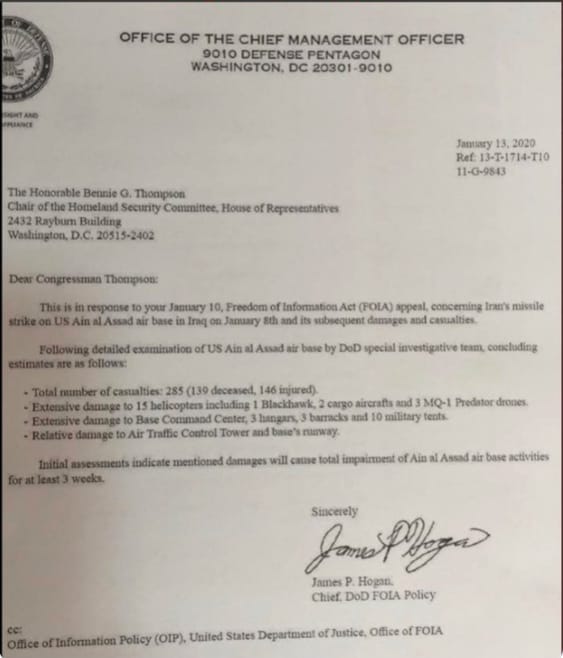
Source: Twitter.com/MPPregent/status/1217808142710595584/photo/1, January 16, 2020
The next day, January 14, Ayatollah Ahmad Alamolhoda – who is known to be a close associate of Khamenei, who represented Khamenei in Khorasan Province and who delivers Friday sermons in Mashhad – said that "hundreds of thousands" of American soldiers had been "turned to dust and ashes" in the missile strike.[10]
A week later, an Iranian animation group released an animated video depicting hundreds of American coffins at the Ayn Al-Asad airbase in the aftermath of the attack.[11]
Iran Notified U.S. Forces Of The Attack Ahead Of Time
Information that has been made public since the attack in both American and Iranian statements reveals that Iran had given the U.S. advance notice that it was going to strike American bases in Iraq with ballistic missiles. Iran's foreign minister at the time, Mohammad Javad Zarif, said that the Iranian regime had informed Iraq of its plans to launch missiles at the U.S. bases, with the intention that Iraq would then inform the U.S. so that precautions would be taken to prevent loss of life.[12] Then-Iraqi prime minister Adel Abdul Mahdi said that his government had indeed been warned of the attack,[13] and an advisor of his told Reuters that Iran had delivered notice of the attack to both Iraq and the U.S. via one Arab country and one European country, which he reportedly declined to name.[14]
First-hand accounts from U.S. military personnel in Iraq provide even more insight. Unit commanders at Ayn Al-Asad described the day of the attack in an official report that was published on a U.S. Air Force website. Lt. Col. Staci Coleman, who was the Commander of the 443rd Air Expeditionary Squadron, and members of her squadron testified that they had been briefed about an impending Iranian ballistic missile attack almost six hours before the attack. Captain Wesley Florez, the Executive Officer of the 1st Expeditionary Rescue Group, said that he had received information about the attack early the previous afternoon.[15] According to reports by Iraqi soldiers at Ayn Al-Asad, U.S. forces started preparing for the missile attack and evacuating the base approximately eight hours before it took place.[16]
Team Sergeant Karla Maldonado and Staff Sergeant Shane Rehbein, who were Air Traffic Controllers with the 442nd Air Expeditionary Squadron at Al-Taqaddum Air Base, which is less than 100 miles away from Ayn Al-Asad, reported that a few hours before the attack on Ayn Al-Asad, they had landed 28 helicopters that evacuated from "nearby bases" to Al-Taqqadum. The report does not specify the location from which these helicopters evacuated. At approximately 4:00 AM, less than two hours after the missile barrage on Ayn Al-Asad was over, the evacuated helicopters began leaving Al-Taqqadum.[17]
The American forces at Ayn Al-Asad airbase apparently had enough advance warning to evacuate 1,000 soldiers and 50 aircraft, and U.S. Army Major Alan Johnson, an intelligence officer who was present at Ayn Al-Asad airbase, said that the intelligence reports even included information that the Iranian ballistic missiles were being fueled.[18]
Perhaps most notable is that CENTCOM commander Gen. Kenneth McKenzie said that the U.S. was aware when Iran started moving its ballistic missiles prior to the attack, that the U.S. knew what intelligence Iran was basing its attack strategy on, and that the U.S. carefully timed the evacuation of personnel from Ayn Al-Asad airbase so that Iran wouldn't "refresh and adjust [its] plans."[19]
SUPPORT OUR WORK

Iranian Lies And Propaganda
Iran's efforts to inform the U.S. of its intentions to strike make it clear that in truth, Iran was apprehensive of an American response to Iranian retaliation for Soleimani's killing.
Three days before the attack, President Trump had tweeted that the U.S. would strike 52 targets in Iran, including important cultural sites, if Iran were to attack any American assets in Iraq.
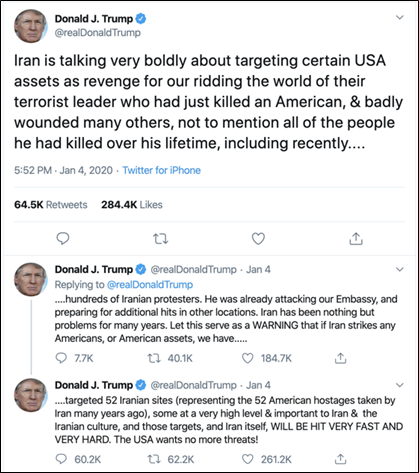
Source: Azfamily.com/news/us_world_news/trump-warns-iran-if-it-hits-any-americans-or-american/image_4389b7e9-8514-5e5a-b5f5-d744f5e9d346.html, January 4, 2020
The next day, President Trump tweeted another warning that should Iran strike any American target, the U.S. would "quickly" and "fully" strike back, "perhaps in a disproportionate manner."
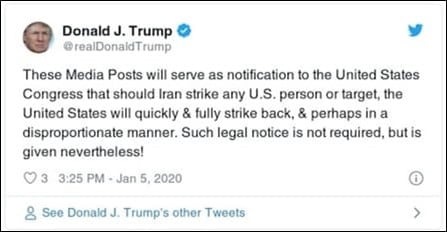
Source: Azfamily.com/news/us_world_news/trump-warns-iran-if-it-hits-any-americans-or-american-assets-we-have-targeted-52/article_5d98b6fb-995f-54c4-9020-7d7b8c4f8ba0.html, January 4, 2020
In the hours after the attack, in what seems like an attempt to de-escalate the situation, Iranian Foreign Minister Javad Zarif tweeted that Iran's "self-defense" measures had been concluded, and that "we do not seek escalation or war."

Source: Twitter.com/jzarif/status/1214736614217469953?lang=en, January 8, 2020
Later, at the same press conference at which he described the extent of the casualties and damage caused by the ballistic missile attack (see above), and still fearing an American retaliation, IRGC Aerospace Force commander Hajizadeh would emphasize that Iran's goal was not to kill U.S. soldiers, but rather to strike American "capabilities and investments."[20]
In addition, according to an exclusive January 8, 2020 Iran Wire report, an unnamed Iranian diplomat had revealed that the missile attack had been launched after several days of discussion by the Iranian Supreme National Security Council, and was "deliberately aimed at military bases and infrastructure and not personnel." The diplomat said that some IRGC officers had insisted that Iran's vengeance against the U.S. must be restrained "because killing Americans will cause an all-out war, which will cause massive destruction in Iran and might even bring down the regime."[21]
It appears that Iran did its best to prevent American casualties in order to avoid an American response. Their concerns may have been justified; General McKenzie himself said: "We had a plan to retaliate if Americans died."[22]
The reality of the Ayn Al-Asad attack makes a mockery of Iran's claims to boldness, fearlessness, and heroism in the face of the United States, and it reveals that Iran's claims about American casualties at Ayn Al-Asad are nothing but lies and propaganda.
Conclusion
The broader meaning of this is that the Iranian regime fears a conflict with the U.S. This explains why the Iranians, despite sharing a border with Iraq, prefer to use Iraqi militias as proxies for operations against American forces, rather than attacking directly. This also explains why Iran repeatedly makes empty shows of force and false claims about confronting American ships in the Persian Gulf – such as the recent fabricated claim that the IRGC had clashed in battle with the U.S. Navy's Fifth Fleet and "humiliated" it after the latter tried to "steal" Iranian oil from a tanker bearing a Vietnamese flag.[23] The truth is that there was no such clash with the U.S. Navy with regard to that oil tanker.
The Iranians' self-praising statements about the attack on Ayn Al-Asad were nothing more than the roars of a fearful paper tiger.
*Yigal Carmon is President and Founder of MEMRI; M. Reiter is a Research Fellow at MEMRI.
[1] See also: MEMRI Inquiry and Analysis No. 1495, The Iran-U.S. Crisis Following Soleimani's Killing – Analysis And Assessment: Part I, January 6, 2020; MEMRI Inquiry and Analysis NO. 1496, The Iran-U.S. Crisis Part II – Iran, The Paper Tiger, January 8, 2020.
[2] The Pentagon stated that 110 soldiers from the Ayn Al-Asad airbase have been treated for mild brain trauma.
[3] Mehr and Fars News.
[4] MEMRI TV Clip No. 7710, Iranian Supreme Leader Ayatollah Ali Khamenei: Our Missile Attacks Were a "Slap" to the Americans; America's Corrupting Presence in the Region Must Come to an End, January 8, 2020.
[5] MEMRI TV Clip No. 7745, Iranian Supreme Leader Khamenei at Tehran Friday Sermon: The 'Bitter Incident of the Plane Crash' must not Overshadow the IRGC 'Crush' of U.S. Bases and Tens of Millions Attending Soleimani's Funeral, January 17, 2020.
[6] Fars News (Iran), January 8, 2020.
[7] MEMRI TV Clip No. 7725, General Amir Ali Hajizadeh, Commander of IRGC Aerospace Force: Missile Attack onU.S. Bases in Iraq Just the Beginning of Revenge; Many U.S. Casualties in Attack; Arab Countries must Expel U.S. Forces from Region or Else ‘Resistance’ Groups will Do So, January 9, 2020.
[8] MEMRI TV Clip No. 8420, IRGC Aerospace Force Commander Gen. Hajizadeh In An Iran TV Documentary: Germans And Japanese Felt Our Attack On Ayn Al-Asad Airbase Was Revenge For WWII; Show Ends With The Trump Family, Pence, Netanyahu Being Targeted By Crosshairs, October 28, 2020.
[9] Washingtonexaminer.com/policy/defense-national-security/fake-pentagon-letter-saying-us-troops-died-in-airstrike-is-iranian-propaganda-analysts-say, January 16, 2020.
[10] MEMRI TV Clip No. 7733, Iranian Ayatollah Ahmad Alamolhoda: U.K. Ambassador Should Be Chopped into Pieces; Hundreds of Thousands of U.S. Soldiers Were Killed in Our Missile Attack; Iranians Who Refused to Step on Flags of Israel, U.S. Should Be Court-Martialed, Executed, January 14, 2020.
[11] MEMRI TV Clip No. 7765, Iranian Animation Group Releases Video Depicting Countless Coffins of American Soldiers in "Aftermath" of Iranian Strike on Ayn Al-Asad Air Base, January 21, 2020.
[12] Mehr News (Iran), January 8, 2020
[13] Reuters.com/article/us-iraq-security-government/iraqi-pm-received-word-from-iran-about-missile-attack-idUSKBN1Z71FX, January 8, 2020.
[14] Reuters.com/article/us-iraq-security-early-warning/hours-of-forewarning-saved-us-iraqi-lives-from-irans-missile-attack-idUSKBN1ZC218, January 13, 2020.
[15] Airandspaceforces.com/app/uploads/2020/04/American-Airmens-Accounts-of-Iranian-Missile-Attack_Jan2020_35MB1.pdf, January 2020.
[16] Reuters.com/article/us-iraq-security-early-warning/hours-of-forewarning-saved-us-iraqi-lives-from-irans-missile-attack-idUSKBN1ZC218, January 13, 2020.
[17]Afcent.af.mil/Portals/82/American%20Airmen's%20Accounts%20of%20Iranian%20Missile%20Attacks/American%20Airmen's%20Accounts%20of%20Iranian%20Missile%20Attack_Jan2020_35MB.pdf?ver=2020-04-07-025930-227, January 2020.
[18] Cbsnews.com/news/iranian-attack-al-asad-air-base-60-minutes-2021-08-08, August 8, 2021; "60 Minutes," Youtube.com/watch?v=lGP7hZQuTL0, February 28, 2021
[19] Cbsnews.com/news/iranian-attack-al-asad-air-base-60-minutes-2021-08-08, August 8, 2021.
[20] MEMRI TV Clip No. 7725, General Amir Ali Hajizadeh, Commander of IRGC Aerospace Force: Missile Attack onU.S. Bases in Iraq Just the Beginning of Revenge; Many U.S. Casualties in Attack; Arab Countries must Expel U.S. Forces from Region or Else ‘Resistance’ Groups will Do So, January 9, 2020.
[21] Iranwire.com, January 8, 2020
[22] "60 Minutes," Youtube.com/watch?v=lGP7hZQuTL0, February 28, 2021.
[23] Kayhan News (Iran), November 6, 2021



